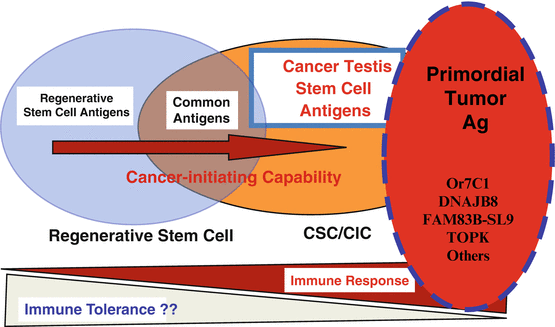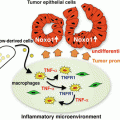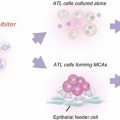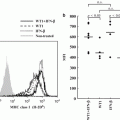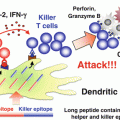Fig. 19.1
Search for transformation-associated cell surface molecules induced by activated oncogene introduction into murine fetal fibroblasts, rat WFB cells and mouse BALB3T3 cells
Meanwhile, as shown in Fig. 19.2, recent progress in regenerative stem cell research has also clarified substantial aspects of the biological features and similarities of CSCs/CICs. It is now known that regenerative stem cells and CSCs/CICs may commonly express various sets of stress-related molecular chaperones, transporters, and detoxification enzymes.
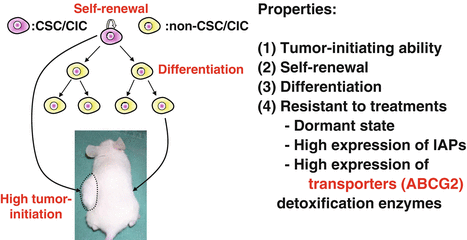

Fig. 19.2
Properties of cancer stem cells/cancer-initiating cells (CSCs/CICs)
The above characteristics can be utilized for isolating CSCs/CICs. For example, the adenosine triphosphate (ATP)-binding transporter, ABCG2, is highly expressed in CSCs/CICs. Therefore, a dye such as Hoechst 33342 cannot stain CSCs/CICs because of the high expression of the transporter, and consequently these unstained cells can be efficiently isolated using a cell sorter (Yasuda et al. 2013; Murase et al. 2009). As shown in Fig. 19.3, cells in the unstained side population (SP) fractions of human cancer cell lines such as LHK2 lung cancer, MCF7 breast cancer, and SW480 colon cancer, obviously have higher capabilities in in vivo tumorigenicity assays using NOD-SCID mice than those in the stained main population (MP) fractions. This is also true in isolation of SP fraction cells from primary colon, lung, and ovarian cancer tissues. Taken together, our experiments indicate that CSCs/CICs are enriched or purified at least to a certain degree in the SP fraction. This fact allows subsequent studies of gene profiles that are expressed specifically in cells of the SP fraction which contain purified CSCs/CICs.
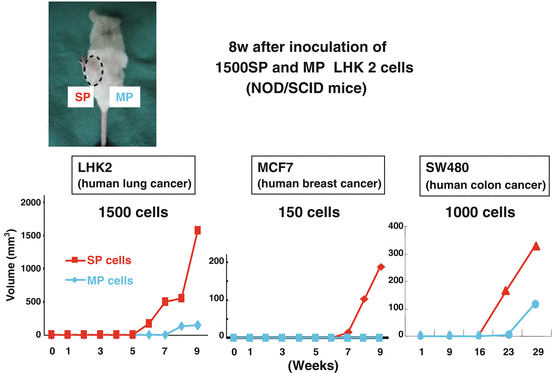

Fig. 19.3
In vivo tumorigenicity assays of non-obese diabetic/severe combined immunodeficiency (NOD-SCID) mouse cells fractionated from the side population (SP) and main population (MP) in cell sorter analysis
19.3 Classification of Molecules Expressed in Human CSCs/ CICs
By DNA microarray, we have analyzed genes of cells from the SP and MP fractions in a total of 60 human cancer lines, including tumors of endodermal (colon, lung, oral cancers), mesodermal (osteosarcomas, myxofibrosarcoma, bladder, prostate, ovarian cancers) and ectodermal (breast cancer and melanomas) origin, as well as primary cancers such as colon, lung, and gynecological malignancies. Consequently, we can summarize and classify genes that are preferentially or specifically expressed in human CSCs/CICs as shown in Box 19.1.
Box 19.1: Classification of Molecules Expressed in Human CSCs/CICs
1.
Cancer Testis Stem Antigens
Or7c1
DNAJB8
Others [SMCP, UBQLN3 (ubiquilin 3), etc.]
2.
Stem Cell Related (iPS-Related)
Sox-2
Oct3/4
Klf4
3.
Stress Response-Related
ABC transporters (ABCB1, ABCG2, etc.)
Detoxification enzymes (ALDH1, aldoketo reductase)
Heat shock proteins (DNAJB8, HSP70A1B, HSP70B9)
4.
Epithelial–Mesenchymal-related
Snail
Twist
CDH2
5.
Others
As suggested in previous works, CSCs/CICs express stem cell- and iPS (induced pluripotent stem) cell-related molecules such as SOX2, Oct3/4, and KIF4. It is interesting that CCSs/CICs also express diverse sets of cellular stress response-related genes. These include ATP-binding cassette (ABC) transporters (typically ABCB1 and ABCG2), detoxification enzymes [aldehyde dehydrogenase (ALDH) 1 and aldoketo reductase], and heat shock proteins (DNAJB8, HSP70A1B, and HSP70B9) (Nishizawa et al. 2012; Torigoe et al. 2009, 2013; Takahashi et al. 2012). We also found that molecules related to epithelial–mesenchymal transition (Snail, Twist, and CDH2) were highly expressed in the SP fraction containing purified CSCs/CICs, when compared with the MP fraction, which contains non-CSCs/CICs.
These gene profiles are indeed very interesting for the biological nature and characteristics of CSCs/CICs. These genes are also expressed in many non-cancerous, regenerative tissue-derived stem cells, suggesting that stem cells, irrespective of their non-cancerous and cancerous aspects, maintain their intrinsic biological actions using these molecules.
Meanwhile, in terms of gene expression that occurs specifically in CSCs/CICs, but not in normal and regenerative stem cells such as mesenchymal stem cells, we found that a substantial number of testis-specific genes were expressed in CSCs/CICs. These include Or7c1 (olfactory receptor family 7 subfamily C member 1), DNAJB8 (DnaJ Hsp40 homolog, subfamily B, member 8), and SMCP (sperm mitochondrial cysteine rich protein), which are highly expressed only in CSCs/CICs, and their expression in normal tissues is limited to testicular cells when analyzed by quantitative polymerase chain reaction (PCR) and immunohistochemistry, indicating that these molecules are typical “cancer testis antigens” (Yamada et al. 2013; Morita et al. 2013).
Interestingly, our subsequent studies also tentatively identified other novel cancer testis antigens that were expressed selectively in CSCs/CICs. The expression of these molecules seems to be regulated via epigenetic mechanisms, particularly DNA methylation and demethylation.
We have also recently clarified that HLA-A24-restricted natural antigenic peptides (NAPs) are specifically expressed in colonic CSCs/CICs. This was determined by comparing cell lines established from SP and MP single clones, by analyzing NAP with mass spectrometry. Interestingly, some of the parental proteins of NAP are cancer testis antigens. Such NAPs are highly immunogenic, as assessed using patients’ peripheral T cells, suggesting the possibility that they could work as potent immunotherapeutic and prophylactic cancer vaccines targeting CSCs/CIs.
19.4 Immunogenic Profiles of Human CSC/CIC-Specific Molecules
At first there was a question whether CSCs/CICs were susceptible to the action of cytotoxic T lymphocytes (CTLs), although CSCs/CICs are generally resistant to chemotherapeutic treatment. To solve this issue, we successfully established an autologous pair of CSC/CIC and CTL clones from soft-part sarcomas. Our data clearly indicated that autologous CTL could lyse CSCs/CICs in the context of HLA class I molecules (Kano et al. 2011). This was the first-ever demonstration that human autologous CTLs were cytotoxic to CSCs/CICs. In other words, the T cell immune system can fulfill the immunological surveillance against CSCs/CICs.
We also investigated whether CSC/CIC antigens such as Or7c1 and DNAJB8 were immunologically potent as well. Their relative capabilities to induce CTL response were compared with non-CSCs/CICs or overlapping shared (common) tumor antigens, i.e., those expressed both in CSCs/CICs and non-CSCs/CICs. To this end, in subsequent experiments we used survivin and Cep55 molecules as shared (common) tumor antigens.
In Fig. 19.4, the data comparing the relative immunoprophylactic potencies to inhibit the in vivo tumorigenic incidence of challenged murine renal tumor cells are shown. In this syngeneic murine immunoprophylactic tumor model, we designed DNA vaccines encoding both DNAJB8 CSC/CIC-specific antigen and shared (common) survivin molecule. When DNA vaccinations were administered twice before tumor implantation, the results clearly indicated that the relative potency to inhibit tumor development was much stronger with CSC/CIC-specific DNAJB8 than with shared survivin (Nishizawa et al. 2012).


Fig. 19.4
Comparison of relative immunoprophylactic potentials to inhibit the in vivo tumor incidence of challenged murine renal cells in mice prevaccinated twice with DNA vaccines containing cancer stem cell/cancer-initiating cell (CSC/CIC)-specific DNAJB8 and survivin shared between CSCs/CICs and non-CSCs/CICs
This was true when we studied the relative capability to inhibit already established human tumor growth in a CTL adoptive transfer model using NOD-SCID mice. In this experiment we established CTL clones that reacted with the HLA-A24-restricted Or7c1 CSC/CIC-specific peptide antigen. To compare the action of CTL we also established CTL clones specifically reacting with the Cep55 shared tumor antigen. Our immunotherapeutic results also clearly demonstrated that adoptive transfer of an Or7c1-specific CTL clone into mice was more potent in inhibiting human SW480 colon tumor growth than Cep55-specific CTL.
As such, CSC/CIC antigens have an obvious advantage in comparison with shared (common) or non-CSC/CIC-specific tumor antigens. Results of both immunoprophylactic and immunotherapeutic experiments strongly suggest that CSC/CIC-specific tumor antigens have theoretical and practical predominance in immunological cancer treatment.
19.5 Cancer Testis Stem Cell Antigens as the New Immunological Milestone
Our recent studies also confirmed that another diverse set of testis-specific antigens, with at least ten or more different molecules, is preferentially expressed in CSCs/CICs (Yasuda et al. 2013; Kuroda et al. 2013; Michifuri et al. 2013; Nishida et al. 2012, 2013; Kitamura et al. 2013b; Michifuri et al. 2012; Hirohashi et al. 2009b, 2010, 2012; Nishizawa et al. 2012; Mori et al. 2012; Nakatsugawa et al. 2011; Kano et al. 2011; Inoda et al. 2009, 2011a, b; Murase et al. 2009; Honma et al. 2009b; Yamada et al. 2013; Morita et al. 2013). Functionally they are suggested to play roles in sperm meiosis, maturation, mobility, and fertilization. Some molecules may also be directly involved in the epigenetic mechanism of spermatogenesis. Thus, it is becoming clear that genes pivotal to maintaining the nature of CSCs/CICs may substantially overlap genes that are indispensable for spermatogenesis and fertilization. Biologically, this is highly intriguing, and here we can propose a novel paradigm for the biological linkage between maintenance of the CSC/CIC phenotype and the molecular mechanisms in spermatogenesis and fertilization.
Meanwhile, from an immunological point of view, most of these molecules are immunogenic. They can induce CTL responses in cancer patients in vitro and in vivo. The Or7c1 molecule is now being used in clinical trials as a novel CSC/CIC cancer vaccine. The DNJB8 vaccine works as a potent immunoprophylactic cancer vaccine in animal tumor models. As shown in Fig. 19.4, its immunogenic potency is actually higher than those of conventional and common tumor (shared) antigens that are equally expressed both in CSCs/CICs and non-CSCs/CICs. Thus, we propose a new category of tumor antigens, called ‘cancer testis stem cell antigens’ as distinct immunobiologic entities.
It is also intriguing that epidemiological data in many countries have shown relatively high mortality in male cancer patients but low mortality in female cancer patients. However, it is not known if the actual CTL response against ‘cancer testis stem cell antigens’ is higher in female patients than in males, so we cannot draw any definitive conclusion as to whether the male immune system is in fact more tolerant of these antigens. Nevertheless, it is possible that ‘cancer testis stem cell antigens’ could play a more pivotal role in female cancer patients than in male cancer patients.
19.6 Summary
Taken together, as illustrated in Fig. 19.5, our studies suggest that CSC/CIC-specific antigens, designated ‘cancer testis stem cell antigens’, are generally highly immunogenic, and should be useful for immunotherapeutic as well as prophylactic treatment of cancers. Since the clonal expansion of peripheral T lymphocytes is limited in vivo, immunological targeting of CSCs/CICs by CTL is thought to be the most rational and efficient approach for the treatment of and prophylaxis against cancers. More importantly, cancer testis stem cell antigens might act as “general, fundamental and primordial” tumor antigens in the basic immune surveillance mechanisms against tumors, particularly CSCs/CICs, by the host immune system (Sato et al. 2009; Hirohashi et al. 2009a; Nakatsugawa et al. 2011).
